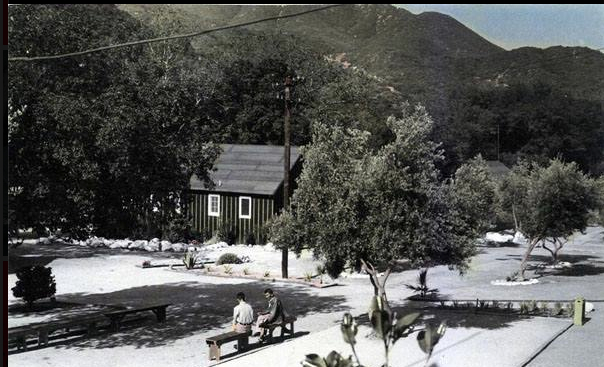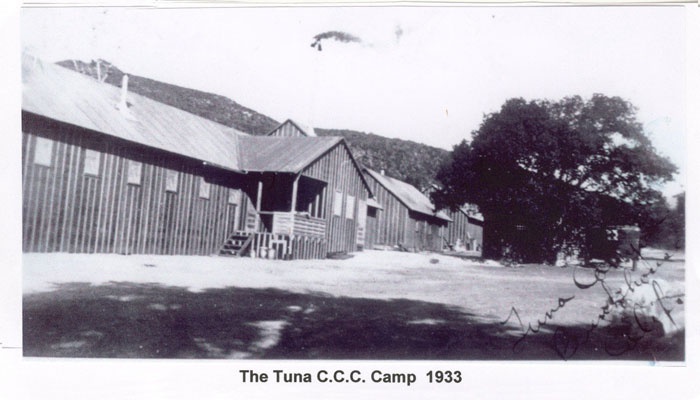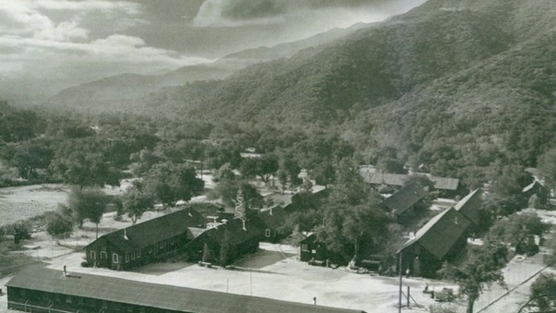Business Spotlight
For Love of Money by Marilyn Tam
Update: LA City Council Approves Motion to Designate 1 Acre Oak Grove Landmark Status at site of former Internment Camp
 Photo Credit: Tuna Canyon Detention Station Facebook Page Photo credited to David Scott, the Scott Family, and Little Landers Historical Society. David Scott is the grandson of Merrill Scott who was the superintendent of TCDS. Photo circa 1941-1943. The structures were removed, but the oak and sycamore trees dating back to World War II still live on this site.
Photo Credit: Tuna Canyon Detention Station Facebook Page Photo credited to David Scott, the Scott Family, and Little Landers Historical Society. David Scott is the grandson of Merrill Scott who was the superintendent of TCDS. Photo circa 1941-1943. The structures were removed, but the oak and sycamore trees dating back to World War II still live on this site.
June 25, 2013 UPDATE:
Los Angeles
The Los Angeles City Council voted unanimously to support an amending motion by Council member Richard Alarcon to declare an approximate one acre live oak and sycamore grove as a historical-cultural monument at the former Tuna Canyon Detention Station in Tujunga in Southern California.
The site was the U.S. Department of Justice internment camp for Japanese, German and Italian Americans during World War II.
The live oak and sycamore trees date back to World War II when the internment camp was in operation.
The Los Angeles Cultural Heritage Commission had recommended against monument status because the original internment camp structures were removed years ago to make way for the Verdugo Hills golf course. The site is now being planned by a developer for a housing development.
Council mmember Richard Alarcon argued that Los Angeles has designated many monuments at sites where the original structures are gone, and he pointed out that trees have also been designated as historic.
For the full story:
Tuna Canyon Detention Station Facebook Page
89.3 SCPR.org KPCC Public Radio, S. California
Volunteers Organized in Conserving the Environment - GCVoice.org\
+ + + + + + + + + + + + + + + + + + + + + + + + + + + + + +
Los Angeles
March 28, 2013
A petition has been launched by the Tuna Canyon Historic Designation Committee on Change.org to grant historical and cultural landmark status to the former Internment Camp located in Tujunga in Southern California.
 Tuna Canyon Detention Station Mess Hall 1933. This building was torn down. Photo: Little Landers Historical Society at Bolton Hall Museum The Los Angeles City Council Committee vote is now scheduled at 2:30pm on Tuesday, June 11, 2013 at City Hall, followed by a full Council vote a week later. On April 18, 2013, the Los Angeles Cultural Heritage Commission voted unanimously against granting historical/cultural landmark status to the former site of the Tuna Canyon Detention Station.
Tuna Canyon Detention Station Mess Hall 1933. This building was torn down. Photo: Little Landers Historical Society at Bolton Hall Museum The Los Angeles City Council Committee vote is now scheduled at 2:30pm on Tuesday, June 11, 2013 at City Hall, followed by a full Council vote a week later. On April 18, 2013, the Los Angeles Cultural Heritage Commission voted unanimously against granting historical/cultural landmark status to the former site of the Tuna Canyon Detention Station.
DailyNews.com writer Rick Orlov reports that Fred Gaines, attorney for developers proposing to build 224 homes on the site which currently operates the Verdugo Hills golf course, says the environmental impact report being developed recognizes the camp's history and is prepared to develop signage and other items to remember its history.
"This motion is a complete waste of time," Gaines told the DailyNews.com. "We have done an environmental impact report (EIR) on the property that included a full analysis of historic issues. "We are at the end of the process and it will be a waste of time to get to the same place we are at."
Rafu.com published this article by Jean-Paul R. DeGuzman about remembering and commemorating the detention station.
Click here to the petition at Change.org.
 A petition is launched at Change.org to designate as a cultural and historic landmark the Tuna Canyon Detention Station. A vote is scheduled June 11, 2013 by Los Angeles City Council Committee.The Densho Encyclopedia resource describes the Tuna Canyon Detention Station as a prison camp that held Issei men from Southern California detained by the FBI shortly after the attack on Pearl Harbor.
A petition is launched at Change.org to designate as a cultural and historic landmark the Tuna Canyon Detention Station. A vote is scheduled June 11, 2013 by Los Angeles City Council Committee.The Densho Encyclopedia resource describes the Tuna Canyon Detention Station as a prison camp that held Issei men from Southern California detained by the FBI shortly after the attack on Pearl Harbor.
The camp also held local German internees and Japanese Peruvians. Internees were held there before being transferred to permanent detention camps in other parts of the country. The capacity of the camp was approximately 300. The site—a former Civilian Conservation Corps (CCC) camp that later became part of the Verdugo Hills golf course—is currently slated for residential development.
Click here to the petition on Change.org.
Read Rafu.com's in depth article by J.K. Yamamoto on the upcoming June 11, 2013 vote by the Los Angeles City Council Committee, and the April 18 vote against granting historical and cultural landmark designation by the Los Angeles Cultural Heritage Commission.
Message for the petition on Change.org by the Tuna Canyon Historic Designation Committee:
We need your help to encourage the Los Angeles City Council to designate the Tuna Canyon Detention Station site as a City Historic-Cultural Monument as proposed by Council Member Richard Alarcon. A Council Committee vote is scheduled on Tuesday, June 11, 2013, followed by a full Council vote a week later.
The Tuna Canyon Detention Station was originally established as a Civilian Conservation Corps (CCC) camp in Tujunga in the Northeast San Fernando Valley during the Great Depression. On December 7, 1941, the Japanese Imperial Military bombed Pearl Harbor, Hawai’i. Within nine days, the CCC camp had been transformed into a high security detention facility with 12-foot high barbed wire fencing, flood lights and armed watch towers installed around the compound’s perimeter.
In February 1942, President Roosevelt signed Executive Order 9066 authorizing the forced removal and incarceration of all people of Japanese ancestry on the West Coast. However, from December 1941 to April 1942, the Justice Department arrested and detained 1,490 Issei or first generation Japanese immigrants at Tuna Canyon. These innocent people were fisherman, priests and pastors, judo instructors, bankers, Japanese language school teachers, and other community leaders who were wrongly suspected of subversive activities. They were imprisoned at Tuna Canyon before being sent to other detention, internment or incarceration camps in the United States. The Tuna Canyon camp processed more than 2,500 individuals, predominantly Japanese, as well as Germans, Italians and Japanese Peruvians.
For more info, visit: https://www.facebook.com/pages/Tuna-Canyon-Detention-Station/356878631079498
The release of records by the National Archives in 2006, coupled with research conducted by the local historical society and Asian American scholars, have shed new light on this little known episode in the history of the City of Los Angeles. Historic-Cultural Monument designation will not stop future redevelopment but will ensure that a portion of the site is set-aside to commemorate history and promote education for future generations. It would allow placement of a plaque on-site and open opportunities to pursue federal grant funds to provide other appropriate commemorative improvements.
We cannot change history but we have a responsibility to acknowledge and learn from it!
- Historic Tuna Canyon Detention Station Coalition


